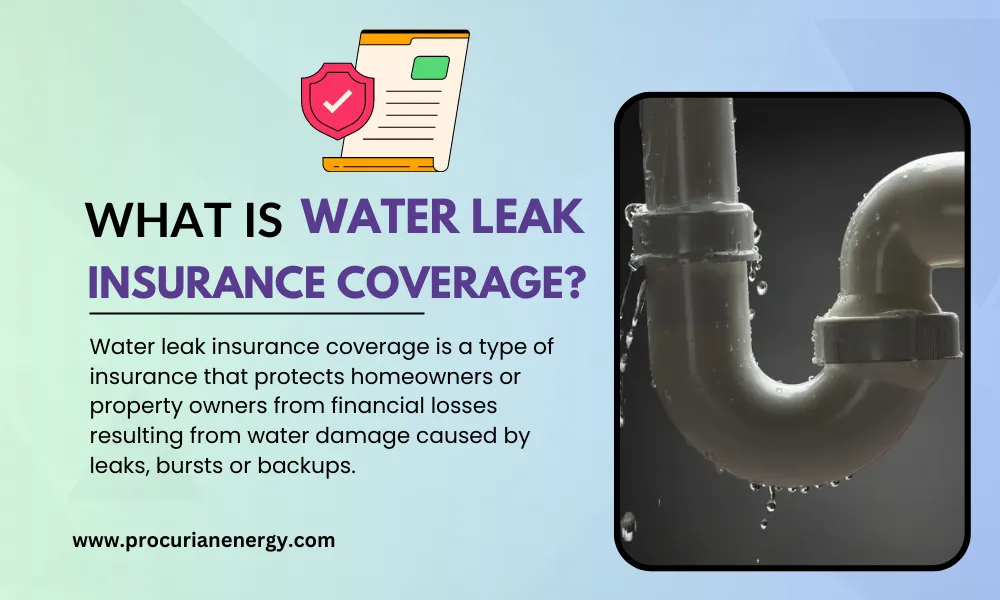Home insurance is a crucial safety net that provides financial protection against unexpected events such as water leaks and damage.
Water leaks can lead to significant property damage, making it essential to understand your insurance coverage and how to navigate the claims process effectively.
We’ll lead you through the process of filing a successful insurance claim for a water leak in this blog, enabling you to protect your house and possessions.
What is Water Leak Insurance Coverage?

Water leak insurance coverage is a type of insurance that protects homeowners or property owners from financial losses resulting from water damage.
Water leak insurance coverage typically includes damage caused by:
- burst pipes,
- leaking appliances,
- sudden water-related incidents.
However, it’s essential to be aware of any exclusions and limitations in your policy such as coverage for gradual leaks or lack of maintenance-related damages.
Thoroughly review your insurance policy to understand what is covered and what isn’t.
Here are detailed guide in steps to make a successful water leak insurance claim:
Step 1: Identifying and Documenting Water Leaks
Water stains on walls or ceilings, musty odors, unusual spikes in water bills and dripping sounds are some of the signs indicating a potential water leak. If you notice any of these signs, act promptly to prevent further damage.
Upon discovering a water leak, shut off the main water supply to your home. If the leak is from a specific source (e.g., a leaking pipe), turn off the water supply to that area. Remove any valuables or furniture from the affected area to prevent them from getting damaged.
Take clear photographs and videos of the water leak and any resulting damage. Proper documentation will strengthen your insurance claim and serve as evidence of the incident.
Step 2: Notifying Your Insurance Company
Review your insurance policy for specific guidelines on reporting water leaks and filing claims. Adhere to the timeframe provided to ensure your claim is valid.
Before contacting your insurance company, gather essential information including:
- your policy number,
- details of the water leak incident,
- the documentation you’ve collected.
When speaking with your insurance company, remain calm, provide clear & concise information and answer all their questions truthfully. Keep a record of all communications for future reference.
Step 3: Working with Professionals
Engage the services of a reputable water damage restoration company to assess and repair the damage. Certified professionals have the expertise to handle water-related issues effectively.
Obtain detailed estimates for the repair costs and any additional reports outlining the extent of the damage. These documents will be vital during the claims process.
Consult with the restoration company about the insurance claim process. They may offer insights and guidance to help you navigate through it smoothly.
Step 4: Filing Your Water Leak Insurance Claim
Fill out the insurance claim form accurately, providing all necessary information about the water leak and the resulting damage.
Include all the supporting documents you gathered such as photographs, videos and the restoration company’s estimates and reports, along with your claim form.
Submit your completed claim form and supporting documents to your insurance company within the designated timeframe.
Step 5: Navigating the Claims Process
Once your claim is submitted, an insurance adjuster will be assigned to assess the damage. Be cooperative and provide access to the affected areas for evaluation.
Answer the adjuster’s questions truthfully and provide any additional information they may request. Remain polite and professional during their visit.
If you believe the initial settlement offer is inadequate, don’t hesitate to negotiate with the adjuster. Provide evidence to support your claim and be willing to compromise when appropriate.
Step 6: Handling Claim Denials or Disputes
If your claim is denied, review the reason given by the insurance company. It might be due to policy exclusions, lack of evidence or other factors.
If you believe your claim was wrongly denied, you have the right to appeal the decision. Follow your insurer’s appeal process and submit any additional evidence to support your case.
If the appeal process is unsuccessful, consider seeking legal advice from a professional experienced in insurance claim disputes.
Step 7: Tips for Expedited Claims Processing
Take swift action after discovering the water leak and submit your claim promptly to avoid delays.
Stay in touch with your insurance company and the claims adjuster to stay informed about the progress of your claim.
Regularly follow up with your insurer to ensure your claim is being processed efficiently.
Step 8: Preventative Measures for Future Water Leaks
Regularly inspect your plumbing and consider upgrading to more durable and leak-resistant materials.
Schedule routine maintenance checks for your appliances, water heaters, and other water-related systems to catch potential issues early.
Install water leak detection systems, use drain screens and maintain proper drainage around your property to minimize water damage risks.
What are the most common water damage claims?
The most common water damage claims typically involve issues such as:
- burst pipes,
- leaking roofs,
- faulty plumbing fixtures,
- appliance malfunctions,
- flooding caused by natural disasters or accidents.
How do you prove water damage?
To prove water damage:
- document the affected areas with photographs or videos,
- collecting water samples for analysis and identifying signs like discoloration,
- mold growth or warping.
It is essential to gather relevant records such as maintenance history and insurance documentation to support the claim or investigation effectively.
What is covered in a water damage claim?
Insurance policies usually compensate for property damage including:
- structural repairs,
- flooring,
- furniture,
- personal belongings damaged by water.
It may also cover additional living expenses if the property becomes uninhabitable during restoration.
How do you maximize recovery on a water damaged claim?
To maximize recovery on a water damaged claim, take the following steps:
- Document the damage with photos and videos.
- Notify your insurance company immediately.
- Mitigate further damage by securing the property.
- Keep records of all communication with the insurer.
- Obtain professional estimates for repairs.
What is the average insurance payout for water damage?
| Type of Water Damage | Average Insurance Payout |
|---|---|
| Burst Pipes | $5,000 – $70,000 |
| Plumbing Issues | $2,000 – $10,000 |
| Appliance Leaks | $1,500 – $5,000 |
| Roof Leaks | $2,500 – $10,000 |
| Flood Damage | $5,000 – $15,000 |
| Sewage Backup | $2,000 – $10,000 |
| Mold Remediation | $500 – $6,000 |
| Water Damage Restoration | $15,000 – $50,000+ |
Will insurance cover hidden water damage?
Standard homeowners’ insurance usually covers sudden and accidental water damage such as burst pipes or leaking appliances.
However, it may not cover damage resulting from neglect or gradual leaks over time.
Policyholders must promptly report water-related issues to their insurer and document the damage thoroughly.
Water Leak Insurance Claim- Important FAQs
Does my homeowners’ insurance cover water leaks?
Yes, Standard homeowners’ policies often cover sudden and accidental water damage caused by burst pipes or leaks, subject to certain terms and conditions.
Are slow, unnoticed leaks covered by insurance?
Unfortunately, insurance usually doesn’t cover gradual damage resulting from long-term leaks.
Will insurance cover all repair costs for water leaks?
Coverage depends on your policy’s specifics. Insurance may cover repair costs for damaged structures but might not cover the cost of fixing the actual leak’s source.
Is mold damage resulting from a water leak covered?
It varies. Some policies may cover mold remediation if it resulted from a covered water leak, while others might have exclusions for mold-related claims.
What should I do if I discover a water leak?
Act promptly! Turn off the water supply, document the damage, take photos and report the claim to your insurance provider as soon as possible.
Will filing a water leak claim increase my premiums?
Filing a claim might increase premiums but it depends on your insurer and claim history. Check with your provider to understand their policy.
Is water damage from flooding covered by standard policies?
No, standard homeowners’ policies usually exclude flooding. You’ll need separate flood insurance to cover damage caused by natural water sources.
What if the water leak is caused by my negligence?
If the insurer determines that negligence led to the leak, your claim might be denied. Regular maintenance is vital to prevent issues.
Can I prevent water leak-related claims in the future?
bsolutely! Regularly inspect plumbing, maintain appliances and install leak detection systems. Quick action can save you from costly damages and claims.
Final Thoughts
By understanding your water leak insurance coverage, promptly identifying and documenting water leaks and following the correct claims process, you can increase the chances of making a successful claim.
Remember to work with professionals, stay proactive and take preventative measures to safeguard your home from future water-related incidents.
A successful water leak insurance claim ensures that your home and belongings remain protected, providing peace of mind for you and your family.









